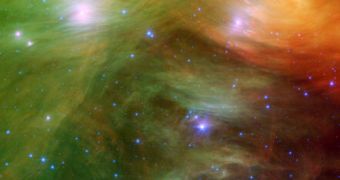The Pleiades' high visibility in the night sky has guaranteed it a special place in many cultures, both ancient and modern. In Greek mythology, they represented the Seven Sisters, while to the Vikings, they were Freyja's hens, and their name in many old European languages compares them to a hen with chicks.
The cluster is now known to lie at a distance of about 135 parsecs, or 440 light years. It is dominated by hot blue stars, which have formed within the last 100 million years. Dust that forms faint reflection nebulosity around the brightest stars was thought at first to be left over from the formation of the cluster but is now known to be an unrelated dust cloud that the stars are currently passing through.
The new infrared image from Spitzer highlights the "tangled silver braid" mentioned in a poem by the 19th-century poet Alfred Lord Tennyson, who described them as "glittering like a swarm of fireflies tangled in a silver braid.".
This spider-web-like network of filaments, colored yellow, green and red in this view, is made up of dust associated with the cloud through which the cluster is traveling. The densest portion of the cloud appears in yellow and red, and the more diffuse outskirts are shown in green hues. One of the parent stars, Atlas, can be seen at the bottom, while six of the sisters are visible at top. Additional stars in the cluster are sprinkled throughout the picture in blue.
The Spitzer data also reveal never-before-seen brown dwarfs, or "failed stars," and disks of planetary debris. John Stauffer of NASA's Spitzer Space Telescope mission says Spitzer's infrared vision allows astronomers to better study the cooler, lower-mass stars in the region, which are much fainter when viewed in optical light. Stauffer, who admits to being biased because the Pleiades is his favorite astronomical object, says the cluster is the perfect laboratory for understanding the evolution of stars.
Astronomers estimate that the cluster will survive for about another 250 million years, when it will have dispersed due to gravitational interactions with the spiral arms of the galaxy and giant molecular clouds.

 14 DAY TRIAL //
14 DAY TRIAL //